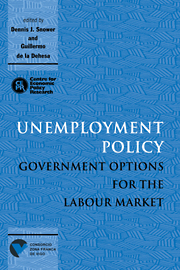Book contents
- Frontmatter
- Contents
- List of figures
- List of tables
- Preface
- Acknowledgements
- List of conference participants
- 1 Introduction
- PART ONE GENERAL POLICY ISSUES
- PART TWO DEMAND MANAGEMENT AND SUPPLY-SIDE POLICY
- 4 The role of demand-management policies in reducing unemployment
- Discussion
- 5 Edmund Phelps' theory of structural slumps and its policy implications
- Discussion
- Discussion
- PART THREE SUBSIDISING EMPLOYMENT AND TRAINING
- PART FOUR LABOUR MARKET REGULATIONS
- PART FIVE POLICY, JOB REALLOCATION AND THE UNEMPLOYMENT–PRODUCTIVITY RELATION
- PART SIX COMPARING UNEMPLOYMENT POLICIES
- Index
Discussion
Published online by Cambridge University Press: 07 September 2010
- Frontmatter
- Contents
- List of figures
- List of tables
- Preface
- Acknowledgements
- List of conference participants
- 1 Introduction
- PART ONE GENERAL POLICY ISSUES
- PART TWO DEMAND MANAGEMENT AND SUPPLY-SIDE POLICY
- 4 The role of demand-management policies in reducing unemployment
- Discussion
- 5 Edmund Phelps' theory of structural slumps and its policy implications
- Discussion
- Discussion
- PART THREE SUBSIDISING EMPLOYMENT AND TRAINING
- PART FOUR LABOUR MARKET REGULATIONS
- PART FIVE POLICY, JOB REALLOCATION AND THE UNEMPLOYMENT–PRODUCTIVITY RELATION
- PART SIX COMPARING UNEMPLOYMENT POLICIES
- Index
Summary
The debate between Edmond Malinvaud and Edmund Phelps provides a significant contribution to the arguments on the unemployment problem, one of the most pressing social issues of our time. Naturally, it is demanding to discuss the review in chapter 5 of Phelps' Structural Slumps: The Modern Equilibrium Theory of Unemployment, Interests and Assets that pushes for a new line of (macroeconomic) thinking. Phelps' work has already been widely appraised by others (for instance, see Woodford, 1994). Hence, I can only be selective, and will discuss Phelps' book directly where appropriate. First, I deal with the general approach to the unemployment problem. Second, I explain where I follow Malinvaud's evaluation and where I depart from it. And finally, I examine more closely the central hypotheses behind the new theory of structural slumps.
Phelps' book and Malinvaud's chapter 5 aim at the understanding of unemployment in a rather general context. This is quite a demanding job – also on a macro level. As we have just learned from Charles Bean's survey on European unemployment (1994, p. 615), there seems to be no lack of hypotheses, but an insufficient ability of the data; we have to confess:
I doubt that more can be learned from analysis of the same data using existing techniques and methodology. There is simply not enough information in the data to give clear signals on the relative merits of the competing hypotheses. […]
- Type
- Chapter
- Information
- Unemployment PolicyGovernment Options for the Labour Market, pp. 151 - 160Publisher: Cambridge University PressPrint publication year: 1997
- 1
- Cited by



